OCZ Vertex 4 Review (128GB), Firmware 1.4/1.5 Tested
by Kristian Vättö on August 4, 2012 10:00 AM ESTAnandTech Storage Bench 2011
Last year we introduced our AnandTech Storage Bench, a suite of benchmarks that took traces of real OS/application usage and played them back in a repeatable manner. Anand assembled the traces out of frustration with the majority of what we have today in terms of SSD benchmarks.
Although the AnandTech Storage Bench tests did a good job of characterizing SSD performance, they weren't stressful enough. All of the tests performed less than 10GB of reads/writes and typically involved only 4GB of writes specifically. That's not even enough exceed the spare area on most SSDs. Most canned SSD benchmarks don't even come close to writing a single gigabyte of data, but that doesn't mean that simply writing 4GB is acceptable.
Originally we kept the benchmarks short enough that they wouldn't be a burden to run (~30 minutes) but long enough that they were representative of what a power user might do with their system. Later, however, we created what we refer to as the Mother of All SSD Benchmarks (MOASB). Rather than only writing 4GB of data to the drive, this benchmark writes 106.32GB. This represents the load you'd put on a drive after nearly two weeks of constant usage. And it takes a long time to run.
1) The MOASB, officially called AnandTech Storage Bench 2011—Heavy Workload, mainly focuses on the times when your I/O activity is the highest. There is a lot of downloading and application installing that happens during the course of this test. Our thinking was that it's during application installs, file copies, downloading, and multitasking with all of this that you can really notice performance differences between drives.
2) We tried to cover as many bases as possible with the software incorporated into this test. There's a lot of photo editing in Photoshop, HTML editing in Dreamweaver, web browsing, game playing/level loading (Starcraft II and WoW are both a part of the test), as well as general use stuff (application installing, virus scanning). We included a large amount of email downloading, document creation, and editing as well. To top it all off we even use Visual Studio 2008 to build Chromium during the test.
The test has 2,168,893 read operations and 1,783,447 write operations. The IO breakdown is as follows:
| AnandTech Storage Bench 2011—Heavy Workload IO Breakdown | ||||
| IO Size | % of Total | |||
| 4KB | 28% | |||
| 16KB | 10% | |||
| 32KB | 10% | |||
| 64KB | 4% | |||
Only 42% of all operations are sequential; the rest ranges from pseudo to fully random (with most falling in the pseudo-random category). Average queue depth is 4.625 IOs, with 59% of operations taking place in an IO queue of 1.
Many of you have asked for a better way to really characterize performance. Simply looking at IOPS doesn't really say much. As a result we're going to be presenting Storage Bench 2011 data in a slightly different way. We'll have performance represented as Average MB/s, with higher numbers being better. At the same time we'll be reporting how long the SSD was busy while running this test. These disk busy graphs will show you exactly how much time was shaved off by using a faster drive vs. a slower one during the course of this test. Finally, we will also break out performance into reads, writes, and combined. The reason we do this is to help balance out the fact that this test is unusually write intensive, which can often hide the benefits of a drive with good read performance.
There's also a new light workload for 2011. This is a far more reasonable, typical every day use case benchmark. It has lots of web browsing, photo editing (but with a greater focus on photo consumption), video playback, as well as some application installs and gaming. This test isn't nearly as write intensive as the MOASB but it's still multiple times more write intensive than what we were running last year.
We don't believe that these two benchmarks alone are enough to characterize the performance of a drive, but hopefully along with the rest of our tests they will help provide a better idea. The testbed for Storage Bench 2011 has changed as well. We're now using a Sandy Bridge platform with full 6Gbps support for these tests.
AnandTech Storage Bench 2011—Heavy Workload
We'll start out by looking at average data rate throughout our new heavy workload test:
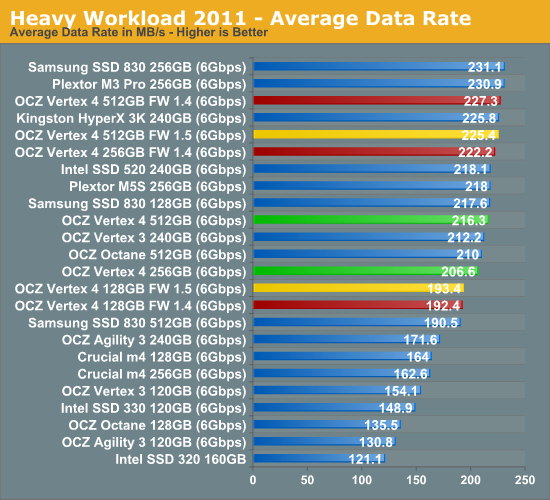
The 1.4 update brought a small boost in our Heavy suite. As you can see in the table above, most IOs are small and the 1.4 and 1.5 firmwares brought marginal improvements to small transfer size performance.
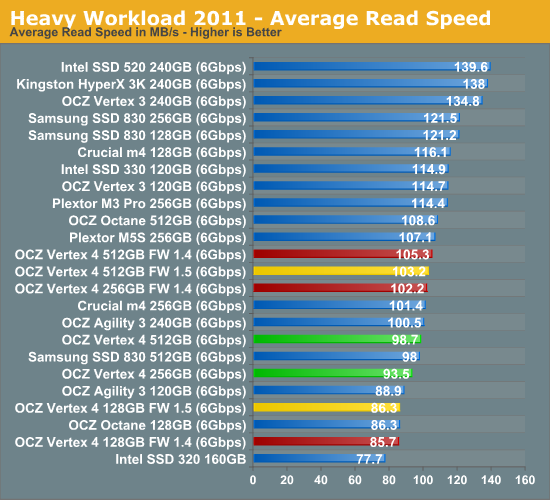
As I mentioned in the previous page, Vertex 4 still lacks read performance at small transfer sizes and the above graphs supports this. The average write performance is very good however and definitely makes up for the middle of the road read performance.
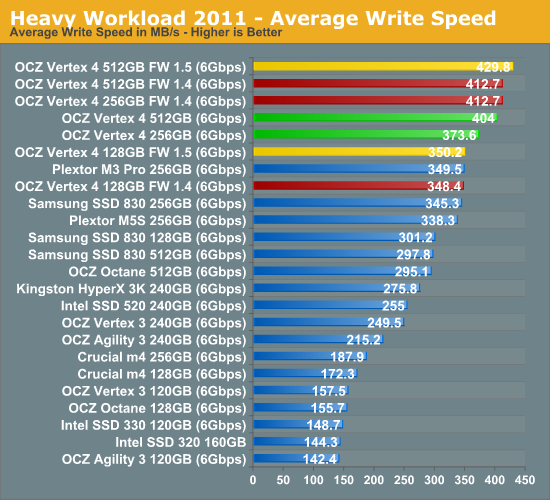
The next three charts just represent the same data, but in a different manner. Instead of looking at average data rate, we're looking at how long the disk was busy for during this entire test. Note that disk busy time excludes any and all idles; this is just how long the SSD was busy doing something:
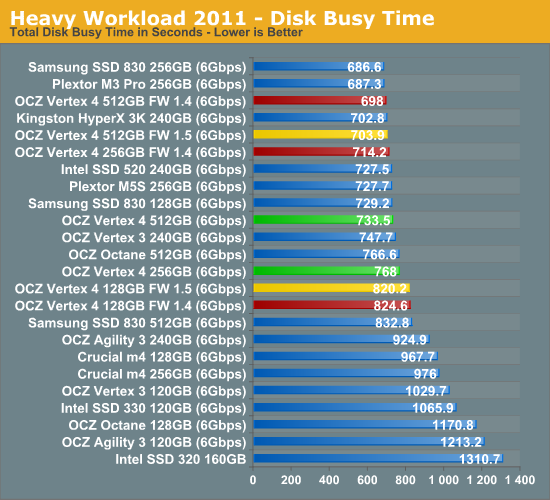
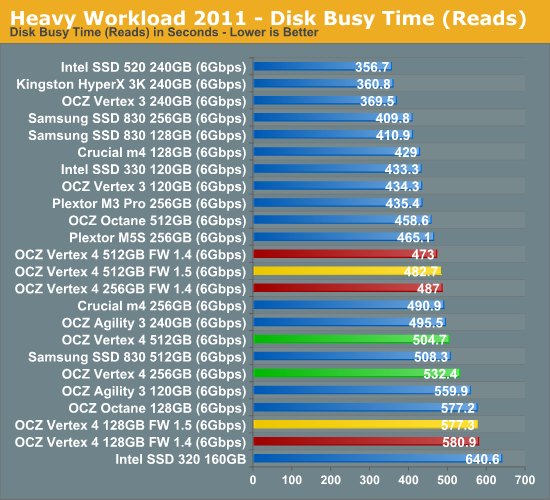
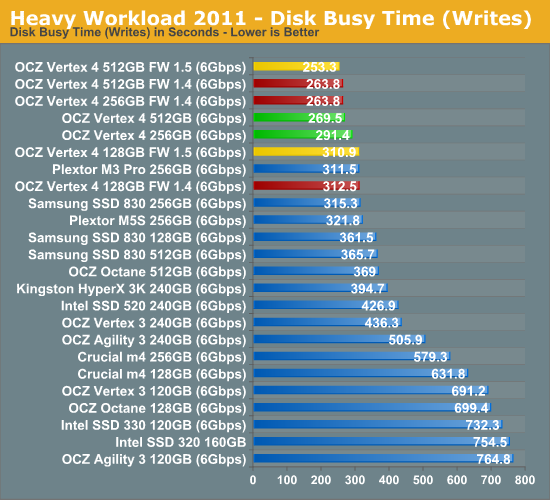










60 Comments
View All Comments
Flunk - Saturday, August 4, 2012 - link
It's not realistic to assume that users will really keep SSDs only 50% full, especially 128GB or 256GB drives. It seems like this feature is purely to benchmark better in reviews and that's low, even for hardware manufacturers. I'm sure that less well-informed reviewers will be tricked by this and publish misleading reviews.To clarify something, I'm not saying that this is a bad product, just that this feature is misleading. If I were set on buying an SSD from OCZ right now I would buy a Vertex 3 because of the price advantage, the performance is a real tossup.
OCedHrt - Saturday, August 4, 2012 - link
My 128 GB is closer to 80% full. However, at that usage any SSD suffers anyways.rs2 - Saturday, August 4, 2012 - link
I agree, this article should have included results taken with the drive "30% Full" and "75% full" in all benchmarks, to demonstrate what will happen in the real world when the 50% mark is passed.ratbert1 - Saturday, August 4, 2012 - link
Tom's wrote an article about how writes are affected by this. Seems on the 128Gb drive they dwindle to 60-70MiB/s when you get over 50%. Interesting theory as to why.http://www.tomshardware.com/reviews/vertex-4-firmw...
Alexvrb - Sunday, August 5, 2012 - link
Yeah, stuff like that makes you think twice about buying a specific model of SSD, until you get a tough review of it. I don't want to read a softball review Kristian. I want to see worst case scenarios. Pit it up against a Samsung 830 in some real-world drive-packed scenarios.jwilliams4200 - Sunday, August 5, 2012 - link
The funny thing is that the OCZ people like Tony gave Tom's a lot of grief for that review, even though the review clearly had test results to back up their claims. The only speculation in the review was about how the performance mode worked on a low-level, but that was clearly labeled as speculation.OCZ is just the worst SSD company there is. They release gimicky products like the "performance mode" V4, and then when people try to give them a thorough review to see what the downsides may be, the OCZ reps whine and complain about the review being unfair or not typical of most usage.
Kristian Vättö - Monday, August 6, 2012 - link
I don't have any Vertex 4s, Anand ran all the tests and I simply did the writing. This article was already weeks overdue so instead of pushing it back by another few weeks at least, we decided to have a "regular" review now and look at the performance mode separately.I do have Agility 4, though, so I can play around with it and see how it behaves.
Laststop311 - Saturday, August 4, 2012 - link
for 95% of consumers the fact that it only runs in performance mode when 50% full will completely go by their head. It's a very dirty under handed tactic to get good benchmark scales by leaving it under 50% than the customer not knowingly gets screwed. I currently own a 7mm height 512GB Crucial M4 in my Asus UX32vd and it has a very steady performance all the way up to 85% used so far. And I only paid 384.99 free shipping and no tax. Takes me less then 8 seconds to do a full boot up and windows 8 will probably lower it to about 4-6 seconds to boot up from cold.I'm pretty sure the 512GB Vertex 4 doesn't come in 7mm height size and I'm damn sure you aren't going to find it for 385 final cost. Also crucial makes every single part of the solid state drive. The make their on nand, dram, controller, firmware. This allows them to take the cream of the crop of components and sell the slightly not as good ones off. Plus they make sure everything is totally compatible and working perfect together since they make EVERYTHING.
Crucial are so solid rock reliable and everything on them works just perfect together and they have great trim and garbage collection and don't lose a huge performance drop at 50% capacity.
Oh did I mention they are dirt cheap. You can easily find a 256GB crucial m4 for right around 180 or a little more. They ware way below $1/GB and perform like the top tier ssd they are.
Did I mention reliable? The old 256GB C300 I have in the optical bay of my m18x works just as good as the day she was born. GO CRUCIAL DIE OCZ
extide - Saturday, August 4, 2012 - link
Actually, the Crucial C300's and m4's use Marvell controllers, which Crucial does not make.Samsung is (one of?) the only companies that make the entire drive, controller and all.
That being said I own a C300 and a few m4's and they work very well, even after a long time.
yyrkoon - Saturday, August 4, 2012 - link
Will just about 100% guarantee that marvel controller has 100% Crucial firmware on it.However, I am not sure which exact drive it was. But Crucial had an SSD that used a dual core ARM A9 MCU for a controller at one point.
With all that said. I buy mostly Crucial only memory products when possible simply because of their business tactics. Simply, they are an old fashion American business. Who realizes their money comes from customers. Who they will bend over backwards for Within reason of course. Then, from the outside looking in. Crucial takes great pride in their product. Always doing the best they possibly can. After that, their customer service is second to none.
Anyways. I am not saying I have never had a problem with a Crucial / Micron product. Because I have. The experience was nothing but pleasurable. Considering I had a problem with one of their products. Which I may add that in 15 years of dealing with Crucial has only happened once. Then since the product I returned was no longer available. They sent me a better product at no cost.
Too bad other companies in the industry can not learn by their example.